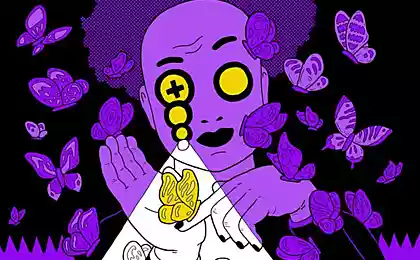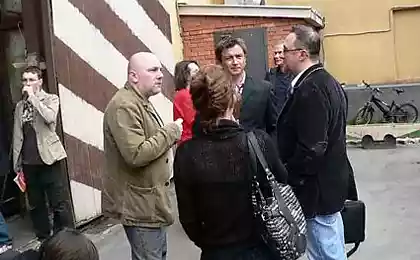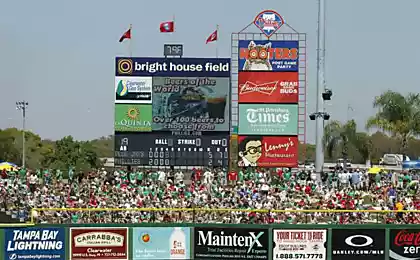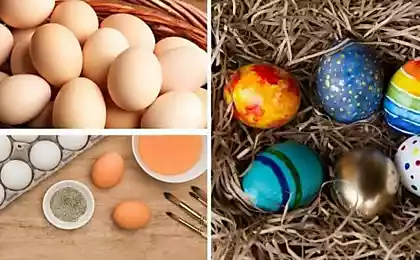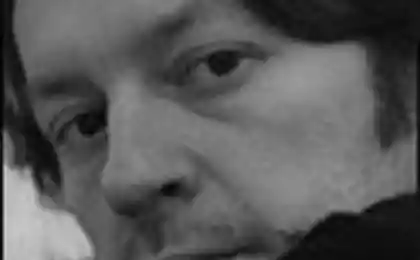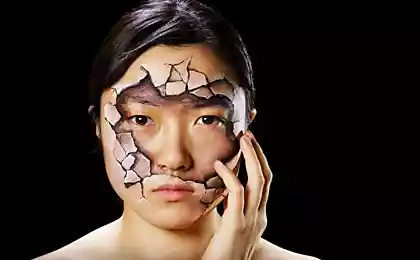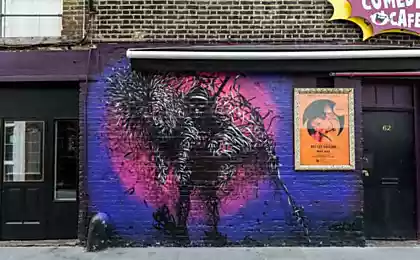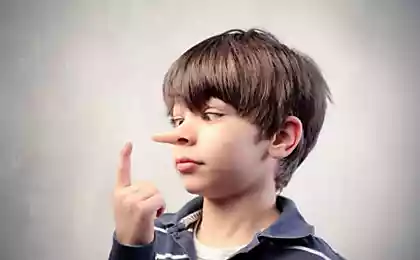692
As the art of deceiving the viewer of anamorphosis, implemented, and trompe l'oeil tableau vivant
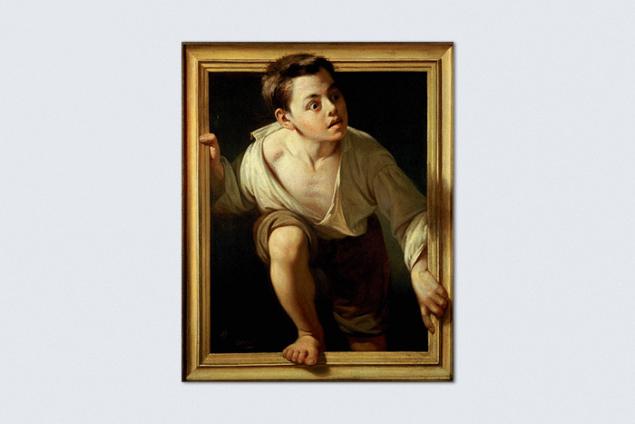
© Pere Borrell del Caso
Art is often a metaphor of the illusion or question the status of reality. Of anamorphosis, turning incredible figure in a crisp objects only due to the choice of the correct positions in space, and trasi effigie, which is a metaphor for the decomposition of the body and ascension of the soul, trample, forcing the birds to break the walls, and the scoreboard vivant that lays out of people the whole composition — the phenomena that allow to understand where the place of reality and whether it exists.
Of anamorphosis: calibration spiritual sinyangana is a special technique in painting, which became especially popular in the XVI century. Anamorphosis can be the whole picture or just a part of it. At first strange, a strange image formed in one of the points of vision in the whole image. Order of anamorphosis became clear looking image, you need to walk around the paintings, finding the only correct viewpoint. On the famous paintings of the classics of painting of the XV–XVI centuries, you can often find the use of anamorphosis with a variety of purposes. The most famous example anamorphoses — painting "the Ambassadors" by Holbein, which shows the Frenchman Jean de Dinteville, Ambassador at the English court, and the Bishop Navorski Georges de Selvam. In the picture you can find a lot of interesting details — for example, tools related to the heavenly world, are on the top shelf, and the "earth" globe is at the bottom. But most of all attracts attention with its unusual bright spot at the bottom of the picture, especially conspicuous against the background of other elements drawn in the traditional realist manner. If desired, it can immediately detect the skull. Even more noticeable it becomes, if in a special way to get up from the right side of the picture: skull in this case is anamorphosis. But why is she included in the story?
About the correct position of the viewer relative to the picture anamorfosi wrote a famous poet-symbolist Jurgis, Baltrusaitis. He considered the relationship of the viewer to the painting through the prism of his movements through the exhibition space. Thus, the viewer acts like an actor in the theater still pictures: "the First action is triggered when the viewer enters through the main door and is at some distance from the two gentlemen, acting in depth on the scene. He is fascinated by their postures, the lushness of the scene. The only thing that disturbs the harmony is a strange body at the feet of the characters. Discouraged, the visitor goes to the right side door, the only thing open, and here begins the second act. Already going into the next room, he turns his head to at last look at the painting, and then suddenly understands everything: the view completely obscures the scene and makes visible the latent image. In the place of former splendor, he sees the skull. The characters and all their scientific instruments disappear, and in their place is a sign of the End. The play concludes". Baltrusaitis seen in "the Ambassadors" is only a metaphor memento mori, invisible to the inattentive, to mundane earthly concerns of the audience. When viewed from the right side of the skull is the only object familiar to prospects — and everything else blurs and fades into the background, like the worldly life before the face of death. However, the secret of anamorphoses is not as simple as it seems at first glance, and hides other meanings.

Hal foster on what visuality
According to the apt remark of a researcher Anton Nesterov, the composition of the painting by Holbein is based on "the effect of significant absence": if you look to the readings of the instruments (quadrant, Gomonov, the celestial sphere, triquetrum), it is possible to establish that the scene happened in the afternoon on 11 April 1533. This day — good Friday, the day devoted to the reminiscences about the death of Jesus on the cross. If you look closely to the left corner, you can see there the hidden crucifix, a kind of reduction of the story of Christ's suffering at Calvary. "Composition chosen by Holbein for the portrait, clearly correlated with the upcoming Cross the virgin and the Apostle John," says Nesterov. Cross in the center, the viewer finds, but sees it from a specific location — the skull of Adam, the traditional iconographic symbol, depicted by the cross on Calvary. The blood of the crucified Christ shed on the skull of Adam in order to atone for all the sins of humankind, including original sin. However, to see that not everyone can — only one who is armed with the true, spiritual vision will be able to find among the myriad of opinions the only true ones. Thus, anamorphosis becomes the means of expression of the Christian sacred knowledge: "the True shape of the world reveals only one point of view."
The skull in the painting by Holbein — is the subject facing into nothing, in other words, the image of castration, which he regarded as a center around which organized gelanyuntian on "the Ambassadors" by Holbein interested in the well-known French philosopher Jacques Lacan. He believed that the interest of art to the anamorphosis was a turning point when the artist first began to use the illusion of space as a hidden reality in order to make a work of art Thing. Lacan considers the blurry skull in the foreground as a phallic symbol: "the Author of anamorphosis compares this figure with the shell of a cuttlefish, while I have it is rather the Association with the two-pound cake that he likes Salvador Dali once to hoist on the head of deliberately messy and unconscious indwelling old woman beggar, or with his own flowing for hours, not less phallic in its significance than the one floating in space the subject that emerges in the foreground of our picture." Lacan indicates that the skull in the painting by Holbein — is the subject facing into nothing, in other words, the image of castration, which he considered as a centre, around which are organized desires. The initial impression of "anamorphoscope Ghost" takes place when the viewer moves to the desired point and then the skull becomes a phallic symbol and a metaphor for the view displayed. The painting catches the viewer's eye and makes him into a trap meanings. Lacan believes that the painting by Holbein — the essence of this idea: "Take any picture and you will see that as you check each point of its surface in search of a perspective this on your eyes disappears."
Implemented and effigia: macabre snag
Not only paintings were able to fool the viewer's eye. In the later middle Ages in Europe were often created sculptural gravestones with the image of lying on them figures of the dead. Depicted on the tombstone of the dead could be as two drops of water similar to more recently living people, then they were called affiliati. Other works was a sculpture of half-decayed corpses. For example, in England is implemented often was a terrible withered body, in France, the main motive was wrapped in a subtle veil or shroud shapes and worm-eaten cadavers, and in Germany is often depicted covered with snakes and toads and corpses. Sculptures were often executed in full human growth, and when they were last used anatomical knowledge of the time. Its frightening realism implemented forced us to think about death, living an idle and empty of spiritual life. Tricking the viewer with its similarities with a real body stone effigy or implemented served as a powerful visual memento mori, which gave to understand that the death of any, even the king.
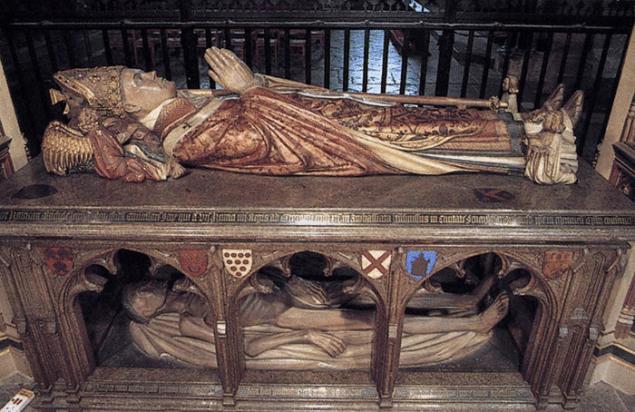
Tomb of Archbishop of Canterbury Henry Chichele
Effigie were regularly used in funerary procedures of the kings after the funeral, Edward II. According to custom mos teutonicus, the flesh and bones of the king of England was separately delivered to the place of burial. To separate the flesh from the bones, the corpse was subjected to boiling and washing in wine. After this procedure, show the dead body was not always possible, and because he was a replacement. Effigy — image of a living king in its coffin, replacing the absent person could be a representation of the integrity of both real and political, according to another example of the body of the king. Effigie were used for official ceremonies, but because the sovereigns they represented, from sculptors clothed in ceremonial clothes with national symbols. Effigiem served as a human — was served food and brought drinks. Then the sculpture was replaced with a real coffin with the body of the ruler. Also popular was the combination of one tombstone effigy, located on top of, and implemented, a representation of a decomposed body, from the bottom. This bundle can be interpreted symbolically: the ugly corpse will remain in the ground, but the real, spiritual "body" of man will ascend to eternal life in heaven. Confirmation of this version can be conventional iconography of a living body, the twin tombs of France: it was depicted on his knees, that is praying before God.
"Catacomb saints" were put on display or kept in reliquary as speaking reminders to the laity: the real, heavenly treasures await all of us only after smartmarine sculptures sometimes built upon the opposite principle: not a stone was trying to portray the dead, but of the bones of the sculptors built a statue. In 1578 in Rome, opened the underground tomb of the first Christians, and the skeletons of the saints were then sent to Germany and Austria, in order to replace relics destroyed during the reformation. "Catacomb saints" were richly decorated: they were dressed in fantastic costumes, wigs were adorned with gold crowns, armor. Then they paraded or stored in reliquary as speaking reminders to the laity: the real, heavenly treasures awaiting us all after death. Research "catacomb saints" is the American scientist Paul Kodomari, who in his colorful books, "Sacred bodies: cult treasures and amazing saints from the catacombs" and "the Empire of death" describes in detail the features of this kind of art and its ritual significance.
Trompe l'oeil: the fight against realestatevoices games with perspective and illusion, whose purpose is to deceive the viewer, to give him a false representation of reality, originate in the days of Ancient Greece. According to the legend related by Pliny, the ancient Greek artist Zeuxis created the first paintings, trompe l'oeil: he could paint grapes so that it sat a bird, deceived by the similarity of the depicted nature.
Report that subsequently Zeuxis painted a boy carrying grapes to the grapes flew the birds, and Zeuxis was angry at his picture, found the same generosity, saying: "the Grapes I painted better than the boy because, if I and the boy drew quite well, the birds would be afraid of him".
Over time, there was a special genre of paintings-trompe l'oeil — trompe-l'œil, French for "illusion". A distinctive feature of trample was the artist's desire to create the appearance that depicted on two-dimensional canvas is a three dimensional object. Famous still lifes-trompe l'oeil, which perfectly fit into the space of the house, and the depicted objects seemed real. One of the most famous paintings faux painting is Borrell del caso "Escape from criticism", which the viewer sees escape from the picture of the boy. Also known sculptural trompe l'oeil: often the figure on the statue covered with a thin veil or as if fitting body and sheer fabric, made of stone.
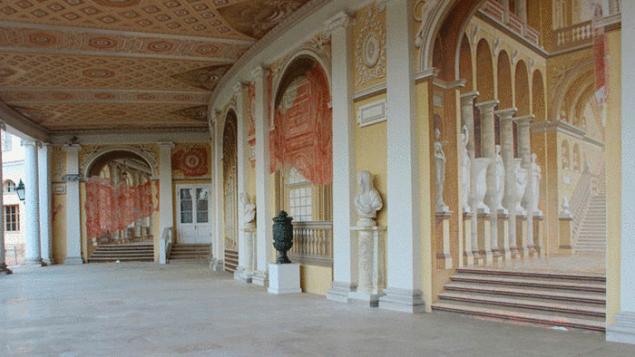
The most famous specimens of trample is a painting of the Italian masters of the late Quattrocento, which were made in temples and intended to expand the space. Di sotto in sù — from the bottom up — people looked at the domes and vaults decorated with images of angels. This illusion had a sacred meaning to the believer need only to direct their eyes to heaven, he will see the Kingdom of God. However, not all trombley was of a religious nature. For example, the famous gallery of the wizard of Gonzago, who worked in the XVIII–XIX centuries in St. Petersburg, is one of the most famous samples of trample in Russia. Three walls of the gallery decorated with frescoes that mimic a green architecture: the audience is immersed in otherworldly space consisting of addictive in itself, of the corridors and colonnades, surrounded by antique statues, vases, chandeliers, Windows falling out of the light and stairs. The gallery gives the impression full of unexplored space, which it imitates — hallways-faux phantasms go towards the void, and once the viewer feels a depth born thanks to artistic illusion, he realizes that actually he deals with frescoes. Terrible impression of incoherence space of peace and space non-existent corridors may overlap only delight experienced in the contemplation technique.
Snag describes not the reality, and the void, causing a feeling other realnosti the image of her friends and the audience beweistheorie genre of trombley engaged the philosopher Jean Baudrillard. In his book "Temptation", he writes about the snag: "there is No stage, no show, no action. All this snag into oblivion, doing a purely decorative figuraccia no matter what". Baudrillard believes that snag describes not the reality, and the void, causing a feeling of a different reality depicted and the viewer familiar things. Trompe l'oeil according to Baudrillard — is a consciously created a simulacrum that simulates the third dimension and, consequently, putting the reality of the third dimension into question. He finds a snag creepy and ironic: she "falls on the reality effect and destroys the evidence of the world."
You can talk about modern faux is a 3D painting on the pavement, and the mirrored shelves of supermarkets, reflecting impossible to eat the amount of food. Space the illusion of simulating reality puts its laws into question — perhaps this is the reason for the popularity of trample to this day.
The tableau vivant: an elegant ekphrasis
Ekphrasis — the description of works of art or architecture in a literary text.
Living pictures, or tableau vivant, is a kind of synthesis of the arts, whose mission is to show famous works of art (sculptures, paintings and the like) in the form of a frozen composition formed from living posers. The tableau vivant is a kind of recursive ekphrasis describing the geometry of human bodies works of art, which itself is a copy of people. Goethe told of the skill of lady Hamilton: "It dissolves your hair, takes a few shawls, and makes a number of changes in postures, gestures, lines and so on, so in the end it just seems like dreaming. The fact that so many thousands of artists would like to portray, see here completely ready in the movements and unexpected changes".
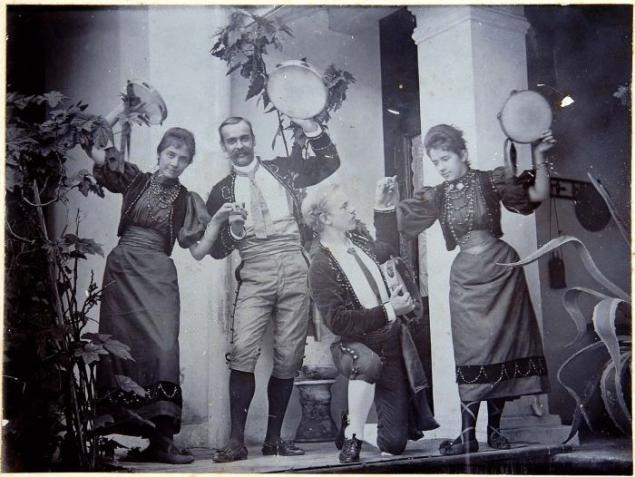
The tableau vivant from the collection of the Tropenmuseum
"She is standing, kneeling, sitting, reclining, serious, sad, sarcastic, lascivious, penitent, caressing, threatening, timid and so on; one after the other, one follows from the other." The tableau vivant was not a ballet or dance — it was posing, which was often attended by many people. For example, in Paris during the Revolution were common scoreboard vivant on themes from ancient history. Participants in these living paintings stood motionless, then the picture closed the curtain, and then again showed the speakers to adopt the new posture. In changing tableaux lined up the plot: for example, in one of his speeches to the German actress Handel-Schutz she was reincarnated from ISIS in a reclining Sphinx, and then caryatids, Galatea, Niobe and Magdalene, showing a medley of classic themes from different eras.
The most popular pageants occurred in the XIX century, it becomes logical if you think of the book Siegfried Kracauer, "Ornament of the masses". The popularity of the pageants may have been a beginning to the process of loss of identity that Kracauer associates with the internal logic of the pipeline, characteristic of capitalism. The high art of the past, to degenerate into new forms adjacent to the grass-roots cabaret and pantomime. Thus, the tableau vivant has just become a new hobby of the aristocracy, tried to revive the art of Antiquity and the Renaissance, but also implicitly expressed the hidden structure of the new epoch, which so often can be seen only in art.published
Source: theoryandpractice.ru
12 unusual types of tourism
Emotional color-blind: why are not all able to realize their own feelings

